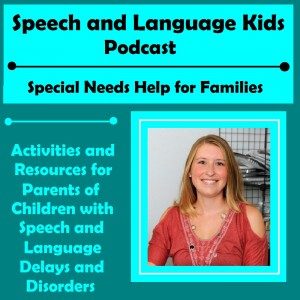This episode will provide an overview of speech and language disorders, delays, and therapies. And in the quick tip, I will tell you about an app that will provide you with tons of words and activities to help you teach your child a new sound.

Speech and Language Disorders Notes:
In this episode, you will get answers to these questions:
** Don’t get overwhelmed, don’t try to remember all
- Speech Delays, Disorders, and Therapies
- Define: specific sound or many sound (common misconception)
- Types of delays and disorders and their therapies
- Articulation Disorder-therapies
- Phonological Disorder-therapies
- Apraxia of Speech-therapies (AAC)
- Motor Speech Disorders-therapies (AAC)
- Language Delays, Disorders, and Therapies
- Define: using language to communicate and understanding the language that others are using to communicate with you
- Areas of language that can be affected: grammar, vocabulary, using words, combining words to make phrases or sentences, asking and answering questions, following directions, reading, writing, social language
- Therapies:
- What an SLP can do
- What you can do at home:
- Fluency/Stuttering
- Define: children who have difficulty speaking with appropriate rhythm
- Types of fluency disorders:
- Stuttering: repeat sounds/words/phrases, get stuck on sounds, physically struggle to get sounds and words out
- Cluttering: speak very quickly and with irregular rate or intonation, leave off sounds, difficulty finding the word to convey what they mean (that place with the people where we went that one time)
- Therapies for fluency disorders:
- SLP does:
- indirect for younger children: demonstrate slow rate, have child identify bumpy and smooth in the SLP’s voice
- ** Many young children go through normal bouts of stuttering, your SLP will help you know if you should be worried or not
- direct therapy
- What You can do at home: talk to SLP first, here are some tips to help ease the pressure at home:
- SLP does:
- Voice Disorder
- Define: Problem with the production of sound from the child’s voice.
- Examples: too loud, too soft, scratchy, breathy, too high/low, hoarse
- Causes:
- physical abnormalities on the vocal cords
- vocal abuse
- learned way of speaking
- Therapies:
- fix physical problems (doctor, not slp)
- vocal rest
- teaching the child how to use the voice appropriately
- Define: Problem with the production of sound from the child’s voice.
How Can I Tell If My Child has a problem in one of these areas?
- Ask your child’s teachers how he compares to other children in his class. Is she worried?
- Compare your child to other children his age. If you aren’t often around other children, take your child to a playground or playplace and watch how he communicates compared to the other children, then ask the other parents how old their children are. Keep in mind, there is a wide range of normal. Your child could be quite a bit behind another child his age but they may both be in the normal range.
- Request a screening by an SLP. Most states have programs that will do this for free for children aged birth-three years. After that, the public schools will do screenings for free, you just need to call your school and ask how to get a hold of a speech-language pathologist
- You can also check out my developmental checklists for children of every age. Go to www.Speechandlanguagekids.com/archives
Speech and Language Disorders Links and Resources
- Speech and Language Kids Collaborative Facebook Group
- Parents of Children with Speech and Language Delays LinkedIn Group:
- Carrie Clark’s Twitter Feed
- Carrie Clark’s Speech and Language Fun Pinterest Board
- How To Teach Your Child A Class of Sounds: www.SpeechAndLanguageKids.com/teaching-long-sounds
- Weekly Speech and Language Activity that you can do at home: www.SpeechAndLanguageKids.com/weekly-activity
- Tips for Parents of Children Who Stutter
- Developmental Checklists for each age (scroll to bottom): www.SpeechAndLanguageKids.com/archive
- Articulation Station App for teaching a child a new sound
As always, don’t forget to head over and rate my podcast or subscribe to future episodes!
More Resources for Speech-Language Pathologists:
Looking for more therapy ideas and resources to help you provide the BEST services to your clients? Join us in The SLP Solution, our membership program for speech-language professionals! Inside the membership, you’ll find:
- Step-By-Step Guides for teaching a variety of speech/language/communication skills
- Pre-Made Worksheets and Therapy Activities for hundreds of different topics
- Training Videos for dealing with difficult disorders or problems
- Answers to Your Questions in our exclusive SLP community
- Tools and Resources to help you with your paperwork and admin tasks
- Continuing Education through our monthly webinars and webinar recordings
To join us in the full SLP Solution, or to snag a free membership, click on the button below!
Podcast: Play in new window | Download | Embed
Subscribe: Apple Podcasts | RSS






Leave A Comment